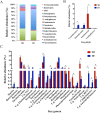Insect-based diet, a promising nutritional source, modulates gut microbiota composition and SCFAs production in laying hens
- PMID: 29176587
- PMCID: PMC5701250
- DOI: 10.1038/s41598-017-16560-6
Insect-based diet, a promising nutritional source, modulates gut microbiota composition and SCFAs production in laying hens
Abstract
Insects could be potential nutritional sources both for humans and animals. Among these, Hermetia illucens, with good amount of chitin and proteins, represents a suitable diet replacement for laying hens. Little is known about insect diet effects on the microbial ecology of the gastrointestinal tract and bacterial metabolites production. In this study we investigated the effect of H. illucens larvae meal administration on cecal microbiota and short chain fatty acids (SCFAs) production in laying hens. 16S rDNA sequencing showed strong differences between cecal microbiota of soybean (SD) and insect diet (ID) groups both in type and relative abundance (unweighted and weighted beta diversity) of microbial species. In particular, Bacteroides plebeius, Elusimicrobium minutum, Alkaliphilus transvaalensis, Christensenella minuta, Vallitalea guaymasensis and Flavonifractor plautii represented the principal contributors of changes in gut microbiota composition of ID group (FDR p-values < 0.05). Of these, F. plautii, C. minuta and A. transvaalensis have the potential to degrade the chitin's insect meal and correlated with the observed high levels of gut SCFAs produced in ID group. These microorganisms may thus connect the chitin degradation with high SCFAs production. Our results suggest H. illucens as a potential prebiotic by well feeding gut microbiota.
Conflict of interest statement
The authors declare that they have no competing interests.
Figures




References
-
- Bovera, F. et al. Yellow mealworm larvae (Tenebrio molitor, L.) as a possible alternative to soybean meal in broiler diets. Br. Poult. Sci. 1–7, 10.1080/00071668.2015.1080815 (2015). - PubMed
-
- Newton GL, Booram CV, Barker RW, Hale OM. Dried Hermetia Illucens Larvae Meal as a Supplement for Swine. J. Anim. Sci. 1977;44:395–400. doi: 10.2527/jas1977.443395x. - DOI
-
- Hale OM. Dried Hermetia illucens larvae (Diptera: Stratiomyidae) as a feed additive for poultry. J. Georg. Entomol. Soc. 1973;8:16–20.
Publication types
MeSH terms
Substances
LinkOut - more resources
Full Text Sources
Other Literature Sources

